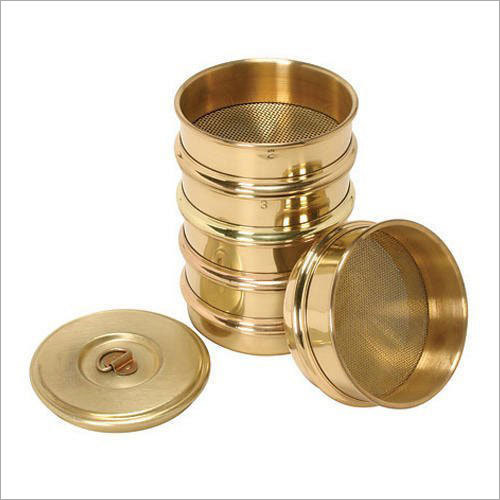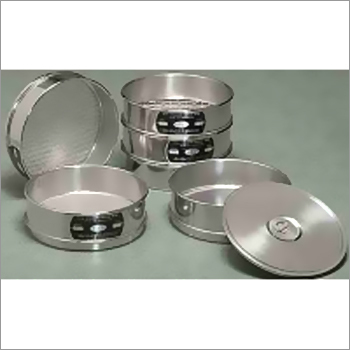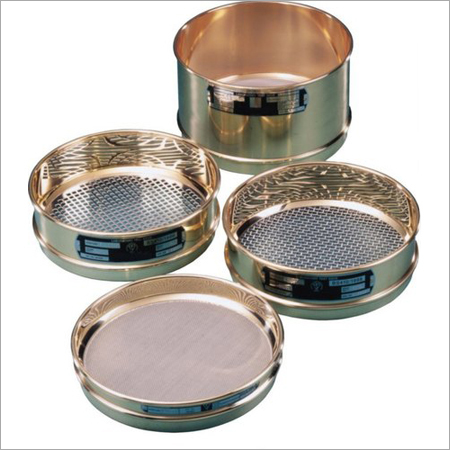Brass and SS Test Sieve
Price 1950 INR/ Piece
Brass and SS Test Sieve Specification
- Response Time
- Immediate (manual)
- Frequency
- Manual use
- Resolution
- As per mesh opening tolerance
- Hardness
- Mesh and frame as per ASTM/ISO standard
- Accuracy
- Complies with ASTM E11, ISO 3310-1 standards
- Mounting Type
- Stackable, Free-standing
- Test Range
- 20 micron to 63 mm aperture sizes
- Max Height
- Up to 6 cm (frame height)
- Power Supply
- Not Required (Manual)
- Automation Grade
- Manual
- Application
- Particle Size Analysis, Laboratory Testing, Sieving of powders and granules
- Measuring Range
- 20 micron to 63 mm mesh openings
- Number of Specimens
- 1 sieve per test stack position
- Equipment Type
- Brass and Stainless Steel Test Sieve
- Features
- Corrosion resistant, Durable frame, Precise mesh fitting
- Specimen Size
- Based on sieve diameter and mesh size
- Usage
- Laboratory and industrial material testing
- Capacity
- Variable based on mesh and frame
- Machine Weight
- Approx. 0.40 kg to 1.20 kg (depending on diameter and frame height)
- Test Speed
- Manual operation
- Test Width
- 75 mm to 300 mm diameter available
- Control Mode
- Manual
Brass and SS Test Sieve Trade Information
- Minimum Order Quantity
- 10 Pieces
- Supply Ability
- 1000 Pieces Per Day
- Delivery Time
- 1 Week
About Brass and SS Test Sieve
Crucial instruments for particle size examination are brass and stainless steel test sieves, which are made of premium brass or stainless steel for longevity. While SS sieves have exceptional corrosion resistance, making them perfect for hostile situations, brass sieves are renowned for their strength and wear resistance. They are made with precision technologies like laser welding and CNC machining and come in a variety of sizes, mesh patterns, and grades (ASTM, ISO). These sieves, which are widely used in mining, food processing, chemicals, and pharmaceuticals, guarantee precise separation and improve quality control. They offer dependable, long-lasting performance in a variety of industries thanks to their sturdy design, resistance, and adjustable options.
Product Details
|
Brand |
Safety Mesh |
|
Usage/Application |
Grading of different type of soil,building materials |
|
Size |
4 to 6 inch |
|
Shape |
Round |
|
Material |
Brass |
Precision and Compliance
Our test sieves conform strictly to international standards such as ASTM E11, ISO 3310, and IS 460. Crafted with a durable brass frame and fine stainless steel mesh, each sieve undergoes rigorous inspection for accuracy and optimum performance in particle size analysis, meeting the requirements of laboratories and industries alike.
Flexible Sizing and Customization
Available in multiple diameters100 mm, 150 mm, 200 mm, and 300 mmand heights of 25 mm or 50 mm, the sieves accommodate various testing needs. Aperture sizes range from 20 micron to 63 mm, and custom options are offered for unique specifications, ensuring compatibility with diverse applications.
Easy Handling and Maintenance
Featuring rolled edges for secure stacking and permanent etching for easy identification, the sieves are designed for convenient manual use. Cleaning is simple, recommended by brushing or ultrasonic methods, and each sieve is supplied in individual protective packaging for safe transport and storage.
FAQs of Brass and SS Test Sieve:
Q: How are brass and stainless steel test sieves used in particle size analysis?
A: These test sieves are stacked together and filled with granular material or powders, then manually shaken or tapped. The sample passes through the mesh apertures, sorting particles by size for precise laboratory analysis.Q: What frame and mesh materials are used in these test sieves?
A: The frames are made of polished brass, while the mesh is constructed from high-quality stainless steel, ensuring both durability and corrosion resistance during repetitive laboratory testing.Q: When should I opt for manual cleaning or ultrasonic cleaning for the sieves?
A: Manual brushing is suitable for routine cleaning after each use. Ultrasonic cleaning is recommended for deeper, more thorough removal of fine particles adhering to the mesh, especially after multiple tests or when using very fine mesh sizes.Q: Where can I use these test sieves?
A: These test sieves are ideal for use in laboratories, research institutions, and industrial settings throughout India, wherever accurate particle size distribution in powders or granules needs to be analyzed according to ASTM or ISO standards.Q: What process should I follow to ensure accurate sieving results?
A: Ensure the sieve stack is assembled with matching diameters and firmly secured. Pour the sample onto the top sieve, close the stack, and manually shake or tap for a consistent period. Collect the separated fractions and weigh or analyze as needed.Q: Are these sieves customizable for specific laboratory needs?
A: Yes, the sieves can be customized for specific diameters, heights, mesh sizes, and packaging according to individual laboratory or industrial requirements. Please specify your needs when ordering.Q: What are the benefits of using brass-framed test sieves with SS mesh?
A: Using a brass frame with SS mesh combines corrosion-resistant strength and high stability with precise mesh openings, resulting in reliable performance, extended lifespan, and ease of identification due to permanent etching of specifications.

Price:
- 50
- 100
- 200
- 250
- 500
- 1000+
More Products in Laboratory Sieves Category
SS Laboratory Test Sieves
Price Range 40.00 - 400.00 INR / Square Foot
Minimum Order Quantity : 100 Square Foots
Test Width : 200 mm (8 inch) and 300 mm (12 inch)
Accuracy : According to IS/BS/ASTM standards
Resolution : Meshdependent
Technilab Test Sieves
Price 1950 INR / Piece
Minimum Order Quantity : 50 Pieces
Test Width : Diameter options: 200mm, 300mm, 450mm
Accuracy : Conforms to IS, ASTM, and BS standards
Resolution : Aperture as per mesh selection

 Send Inquiry
Send Inquiry



